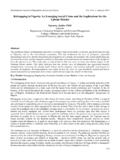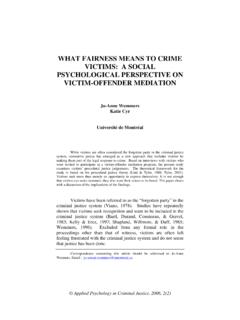Transcription of Financial crime management - EY
1 Financial crime managementThe evolution of borderless Financial crimeDecember 2013 Executive summary: The evolution of borderless Financial crimeThe Financial services industry is facing an emerging era of borderless, networked Financial crime threats. Is the industry ready?The emerging threat A new era of increasingly complex, coordinated, global Financial crime attacks by professionals who are highly networked, well informed, well organized and borderlessThe current gap Structured attacks that fly under the radar of siloed organizations and technologies to exploit organizational boundaries and blind spotsThe necessary response Connect people, data and technologies pervasively to promote fully informed, client-centric risk assessment and surveillance across organizational boundaries| Financial crime management The evolution of borderless Financial crime1 Attacks consist of multiple phases executed by a borderless network of specialists.
2 Hackers quietly and systematically probe and map Financial crime controls of banks and third-party processors by using a combination of modalities, including ID theft/takeover, denial of service (DoS), and device/network compromise. Once vulnerabilities and organizational blind spots have been mapped, criminals rapidly launch large, multi-stage, cross-channel attacks via card fraud, money transfer fraud, first-party fraud and, increasingly, insider fraud. Kingpins launder funds through the global banking system. Despite having robust controls, leading Financial institutions are victimized due to weak links outside of their controls, such as payment network members and third-party service facts Top threats as ranked by deposit fraud executives1 Debit card fraud Cross-channel attacks Organized rings Eighty-two percent of fraud goes undetected until client Seventy-seven percent of firms have been victims of external attacks in the past Sixty-six percent of firms have no formal security architecture Eighty-four percent of fraud executives say current controls fail to keep up with evolving threats.
3 Struggle to work across channels and/or are difficult to integrate with other applications and Financial crime management The evolution of borderless Financial crime |23 Recent case studyProfessionalization of Financial crime is happening today. Large US and foreign Financial institutions have been victimized in recent storyline A Middle Eastern bank relies on an offshore card processor to handle stored-value transactions. A global network of hackers conducts a surgical penetration of the offshore processor, eliminating withdrawal limits and manipulating stored-value balances on accounts. The penetration enables the withdrawal of unlimited amounts of cash. The compromise goes undetected. Criminal casher rings in dozens of cities conduct rapid, synchronized unlimited operations to withdraw large sums of cash from ATMs of large banks.
4 Funds are laundered by kingpins through structuring, layering and purchasing high-value goods that are subsequently transported withdrawal activity over five hours by one casher in Manhattan, Feb 19, 2013. Selected large withdrawals are 4:11 , $4,0152. 5:10 , $2,4093. 5:28 , $2,4094. 6:17 , $2,4095. 6:24 , $2,4096. 6:43 , $2,4097. 8:55 , $2,4098. 9:24 , $5,6219. 9:55 , $4,0151234567894 Financial crime management The evolution of borderless Financial crime |The facts $45m stolen in two ATM-withdrawal sprees on Dec. 22, 2012, and Feb. 19 20, 2013, including $ stolen from ATMs in Manhattan over a 10-hour period February 19 20, 20134 27 countries in which ATMs were raided5 17 prepaid credit card accounts used5 40,500 total ATM withdrawals, including 2,904 withdrawals in Manhattan5 Jun 13 Apr 13 Mar 13 Feb 13 Jan 13 Dec 12 Nov 12 Oct 12 May 13 Targeted hacker attacksLarge-scale ATM cash runsLaundering of proceedsThe timelineKey takeawaysLarge Financial institutions need to take measures now to prevent the growth of this new era of borderless Financial the banks responsible?
5 Financial institutions involved generally maintained effective, FFIEC-compliant control environments. Neither the issuing banks nor the ATM owners were compromised. Despite having effective internal controls, these institutions fell victim to security vulnerabilities of their third-party card processors. The contracting institutions are responsible for understanding, assessing, confirming compliance and monitoring the control environments of their outsourced service providers. A recent McKinsey article summarized the position of regulators: Activities can be outsourced, but responsibility can t. 6 Which controls were missing? The issuing banks may not have consistently followed vendor management best practices, such as security audits, risk assessments and penetration testing. Banks and third-party processors were slow to detect and respond to the massive cash-out.
6 Robust, risk-based card fraud transaction monitoring must be in place, but that is not enough. The ability to raise limits on withdrawals should be a system-enforced permission granted to only a limited set of trusted administrative accounts. Thorough background checks, approval processes and activity monitoring must be in place for these accounts. Changes made to transactional systems should require a systematic approval process, including segregation of duties to enforce security did criminals gain access? Evidence suggests that access was gained through Advanced Persistent Threats (APTs), a combination of coordinated attack vectors, including hacking, phishing, social engineering and denial of service. Insiders employed by third-party processors may have conspired with the professional criminals to gain | Financial crime management The evolution of borderless Financial crimeImplement practical preventive measuresIrrespective of who is at fault, large global Financial institutions risk Financial , reputational and customer satisfaction damage from borderless attacks.
7 Institutions should augment controls, including:Formalize the organization s security architecture frameworkConduct supplier risk and security management reviewsEnhance monitoring of card account, transactional activity and network activityDevelop intelligence and information-sharing capabilities Link information security architecture to business strategy and risk appetite in order to support growth, innovation and optimization, while enhancing protection and governance Implement a highly interconnected architecture across the institution and its third-party processors to give monitoring systems and fraud/security analysts a complete, global relationship-level picture of all activity Conduct ongoing risk-based reviews of security controls, verifying that each employee has only the absolute minimum-required access and ensure systematically enforced segregation of duties Consistently apply strong supplier risk and security management processes Include initial service provider due diligence in robust security reviews Perform annual, independent, risk-based reviews of all service providers who handle transactional or customer activity to ensure they have defined and implemented effective, appropriate, consistent policies, processes and control structures to identify and adapt to emerging threats Build real-time, detailed behavior profiles for each device, ATM and relationship Automatically apply interdiction controls based on anomalous behavior and link analysis Expedite implementation of card chip-and-pin (Europay, MasterCard and Visa, or EMV)
8 To take advantage of enhanced security features for customers who present EMV-enabled cards Assess the effectiveness of transaction surveillance systems to ensure mass compromise can be systematically detected and automatically stopped Review ATM configurations to identify and remove unnecessary services and ensure configurations are current Implement a dedicated Financial crime Intelligence function to monitor external fraud alert networks and internal sources with the objective of anticipating and preventing loss from emerging Financial crime patterns Proactively monitor patterns of fraud, social engineering and link analysis Implement an ongoing process to extract intelligence from all available data on signals and trends to create and implement actionable risk-mitigation strategies before attacks begin6 Financial crime management The evolution of borderless Financial crime |7| Financial crime management The evolution of borderless Financial crimeEY can helpEY has.
9 A proven track record of assisting Financial institutions to assess, improve, and transform their Financial crimes capabilities A team of experienced fraud management and information security consultants, including former executives from the banking industry as well as leading software vendors Highly relevant experience configuring and deploying turnkey fraud, security and compliance technology solutions Deep banking and payments industry domain knowledge Knowledge and hands-on experience across the complete software development life cycle Experience with leading software vendors and leading analytics and decision support technologiesEY can provide: Assistance with assessment, strategic planning, design, and implementation of security and Financial crime processes and technologies based on our extensive experience with fraud management , information security, supplier risk management , and analytics Guidance from our experienced global fraud management and information security practices on industry trends in key markets around the world Insight into global trends and practices across the Financial landscape Flexible cost models to deliver global operational and technology solution implementationsFor the fourth year in a row, EY has been recognized by s Operational Risk & Regulation magazine as the best overall consultancy.
10 We were also recognized as the number one consultancy for fraud/ Financial crime prevention in the magazine s latest report (2011).78 Financial crime management The evolution of borderless Financial crime |910 Financial crime management The evolution of borderless Financial crime |To hear more about how our team can help you, please contact the following professionals: Ron GiammarcoPartner, Financial Services Ernst & Young LLP +1 212 773 3409 Nik WalserSenior Manager, Financial Services Ernst & Young LLP +1 212 773 5506 David NussenbaumSenior Manager, Financial Services Ernst & Young LLP +1 212 773 4523 Key contactsEY | Assurance | Tax | Transactions | AdvisoryAbout EYEY is a global leader in assurance, tax, transaction and advisory services. The insights and quality services we deliver help build trust and confidence in the capital markets and in economies the world over.















